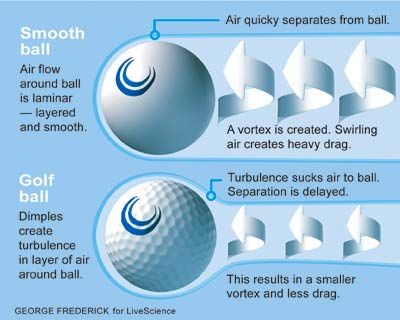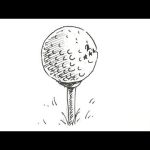A golf ball typically has 300 to 500 dimples. The exact number varies depending on the manufacturer and design.
Golfers often wonder about the small indentations on their golf balls. These dimples, ranging from 300 to 500, play a crucial role in the ball’s aerodynamics. They reduce air resistance and enhance lift, allowing the ball to travel farther and more accurately.
Manufacturers carefully design these dimples to optimize performance. The arrangement, depth, and size of dimples can significantly impact how a ball behaves in flight. Understanding these tiny details can give golfers an edge on the course. So, next time you tee up, remember that those dimples are not just for show; they are key to improving your game.
Introduction To Golf Balls
Golf balls are small, yet vital to the game of golf. They are designed to travel long distances with precision. Understanding their history and evolution can enhance your appreciation of the game.
History Of Golf Balls
The first golf balls were made of wood. These balls were used during the 14th century. In the 17th century, featherie balls became popular. These were made by stuffing feathers into a leather pouch. Later, in the mid-19th century, gutta-percha balls were introduced. These were made from the sap of trees found in Malaysia.
Evolution Of Design
Over time, the design of golf balls has changed significantly. Modern golf balls have a core and multiple layers. The most noticeable change is the addition of dimples. Dimples help the ball travel further by reducing air resistance. A standard golf ball has between 300 to 500 dimples.
| Era | Material | Key Feature |
|---|---|---|
| 14th Century | Wood | Basic design |
| 17th Century | Feather and Leather | Featherie balls |
| Mid-19th Century | Gutta-Percha | Durable and affordable |
| Modern Era | Composite Materials | Dimples for aerodynamics |
Anatomy Of A Golf Ball
The anatomy of a golf ball is crucial for understanding its performance. Each part of the ball plays a specific role. The structure includes the core, the outer cover, and the dimples. Let’s dive into these components.
Core Materials
The core is the heart of the golf ball. It affects the ball’s speed and distance. Most cores are made of rubber or synthetic materials. Here are some common core materials:
- Rubber: Provides elasticity and energy transfer.
- Synthetic Polybutadiene: Enhances durability and performance.
- Liquid-filled: Offers unique feel and control.
The core’s design varies between brands and models. Some balls have a single-layer core. Others have multi-layer cores for different playing styles.
Outer Cover
The outer cover protects the core and affects the ball’s feel. There are two main types of outer covers:
| Cover Type | Material | Characteristics |
|---|---|---|
| Surlyn | Ionomer Resin | Durable and provides more distance. |
| Urethane | Polyurethane | Softer feel and better control. |
Surlyn covers are common in distance balls. Urethane covers are preferred for better spin and control. The choice of cover affects the overall performance.
The Science Behind Dimples
Have you ever wondered why golf balls have dimples? These tiny indentations are not just for show. They play a crucial role in the ball’s performance. Engineers and scientists have spent years studying how these dimples affect a golf ball’s flight. Let’s dive into the fascinating world of golf ball aerodynamics and flight stability.
Aerodynamics
Aerodynamics is the study of how air interacts with moving objects. For golf balls, dimples are essential for improving aerodynamic performance. A smooth ball would not travel as far. The dimples create a thin layer of air that clings to the ball’s surface.
This layer of air reduces drag. Reduced drag means the ball can travel further. The dimples also help generate lift. Lift is the force that keeps the ball in the air longer.
Flight Stability
Dimples also contribute to the ball’s flight stability. They help the ball maintain a steady path. Without dimples, the ball would wobble more during flight. This wobbling would make it harder to control.
Dimples create a more predictable flight pattern. This predictability is crucial for golfers aiming for accuracy. Stable flight means more consistent shots.
Here is a quick summary of why dimples are important:
- Reduce drag
- Increase lift
- Enhance flight stability
- Improve accuracy
Golf ball manufacturers experiment with different dimple patterns. The aim is always the same: to optimize performance. The number of dimples can vary, but most golf balls have between 300 and 500 dimples.
In summary, dimples are not just a design feature. They are a product of extensive scientific research. They make a significant impact on a golf ball’s performance.

Credit: tomorrowgolf.com
Standard Dimple Patterns
The design of a golf ball’s dimples is crucial. It influences how the ball flies. Standard dimple patterns help the ball achieve consistency. Let’s explore common configurations and variations in design.
Common Configurations
Most golf balls have between 300 and 500 dimples. The most popular configuration is 392 dimples. These dimples are typically arranged in a symmetrical pattern. Symmetry helps the ball maintain a straight flight path. Here is a table showing common dimple counts and their patterns:
| Dimple Count | Pattern Type |
|---|---|
| 300 | Hexagonal |
| 336 | Octahedral |
| 392 | Icosahedral |
| 500 | Tetrahedral |
Variations In Design
Golf ball manufacturers experiment with different dimple designs. Some balls have shallow dimples. Others feature deeper dimples. The depth of the dimples affects the ball’s lift and drag. Here are some variations:
- Shallow Dimples: Less drag, more distance.
- Deep Dimples: More lift, better stability.
- Mixed Depth Dimples: Balanced performance.
Some golf balls even feature asymmetrical dimple patterns. These designs are meant for specialized play. They can enhance spin or reduce it, depending on the pattern.
Impact On Performance
Golf ball dimples, or divots, significantly affect game performance. These tiny indentations play a crucial role in how the ball behaves in the air. Understanding their impact can help golfers improve their game.
Distance And Accuracy
Divots on a golf ball help reduce air resistance. This reduction allows the ball to travel farther. The specific pattern of dimples ensures a consistent flight path.
Without these divots, the ball would not fly as efficiently. Consistent divots can lead to more accurate shots. Golfers often seek balls with specific dimple patterns for better control.
Spin Control
Dimples also influence the ball’s spin. The right dimple design can increase backspin. This backspin helps the ball stop quickly on the green.
For advanced players, controlling spin is crucial. It allows them to execute different types of shots. Choosing the right ball can make a significant difference in their game.

Credit: www.fenixxcell.com
Manufacturing Process
The manufacturing process of a golf ball is fascinating. It involves precise techniques and strict quality control. This ensures that each ball performs consistently on the green.
Molding Techniques
Golf balls start their journey in a mold. The mold shapes the core. The core is usually made from rubber.
Next, the mold adds the outer layers. These layers are made from different materials. These materials include Surlyn and urethane. Each layer impacts the ball’s performance.
The final step is adding the dimples. These dimples are crucial. They help the ball fly farther and straighter. The mold shapes the dimples precisely.
Quality Control
Every golf ball undergoes rigorous quality control. This ensures that all balls meet the standards. Each ball is inspected for defects. This includes checking the shape and the number of dimples.
Manufacturers use advanced technology for this. They use machines and cameras to inspect the balls. They ensure each ball is perfect. A table summarizing the key quality checks is shown below:
| Quality Check | Description |
|---|---|
| Shape Inspection | Checks for roundness |
| Dimple Count | Ensures correct number of dimples |
| Material Integrity | Ensures no cracks or weaknesses |
Quality control is vital. It ensures that each golf ball performs reliably. This attention to detail helps golfers play their best game.
Choosing The Right Golf Ball
Choosing the right golf ball is crucial for improving your game. The type of golf ball can impact your performance significantly. Let’s explore the factors that can help you make the best choice.
Skill Level Considerations
Your skill level plays a big role in selecting a golf ball. Beginners often benefit from balls that offer more forgiveness. These balls typically have a softer feel and help reduce spin. This can help with straight shots.
Intermediate players may prefer balls that provide a balance of distance and control. They might look for a two-piece or three-piece ball. Advanced players often seek multi-layered balls. These offer greater spin control and precision. They can capitalize on their skills with these balls.
Weather Conditions
Weather conditions can also affect your choice of golf ball. In windy conditions, low spin balls can be very helpful. They tend to cut through the wind better and maintain a straighter trajectory.
In cold weather, balls tend to become harder and lose some distance. Opt for a softer ball to compensate for this loss. On hot days, a firmer ball might perform better. The heat can make the ball softer and add distance.
Here is a quick reference table for different weather conditions:
| Weather Condition | Recommended Ball Type |
|---|---|
| Windy | Low Spin |
| Cold | Softer |
| Hot | Firmer |
By considering these factors, you can select a golf ball that complements your game. This will help you perform better on the course.
Future Innovations
The golf ball is evolving. Future innovations will change its design. These changes aim to improve performance and sustainability. Let’s explore the advancements.
Technological Advances
Technological advances are shaping the future of golf balls. Engineers are using 3D printing to create unique designs. This technology allows for precise control over the ball’s divots.
Smart materials are another exciting development. These materials can adapt to different conditions. A golf ball with smart materials can improve your game in various weather conditions.
| Technology | Benefit |
|---|---|
| 3D Printing | Custom divot designs |
| Smart Materials | Adaptability to weather |
Sustainability Efforts
Sustainability is a major focus for future golf ball designs. Manufacturers are exploring eco-friendly materials. These materials aim to reduce environmental impact.
Biodegradable golf balls are one such innovation. These balls break down naturally, reducing waste. Another effort is using recycled plastics for making golf balls.
- Eco-friendly materials
- Biodegradable golf balls
- Recycled plastics

Credit: deemples.com
Frequently Asked Questions
How Many Dimples Are There On A Golf Ball?
A golf ball typically has 300 to 500 dimples. The exact number varies by manufacturer and model.
How Many Dimples Are On A Pro V1?
A Pro V1 golf ball has 388 dimples. This dimple pattern enhances flight stability and control.
How Many Grooves Does A Golf Ball Have?
A golf ball typically has between 300 and 500 dimples. The exact number varies by manufacturer and model.
What Are The Divots In Golf Balls Called?
The divots in golf balls are called dimples. Dimples help reduce air resistance and increase lift, improving performance.
Conclusion
Understanding the number of dimples on a golf ball can enhance your game. Each dimple affects the ball’s aerodynamics. The dimple count varies between brands, typically ranging from 300 to 500. Choose a golf ball that suits your style. Better knowledge leads to better performance on the golf course.





